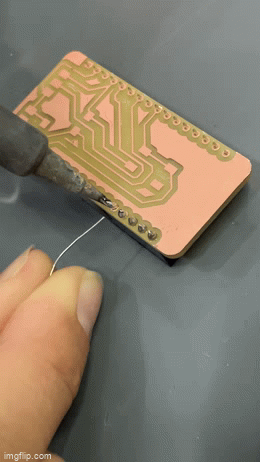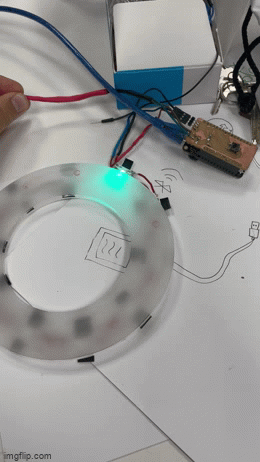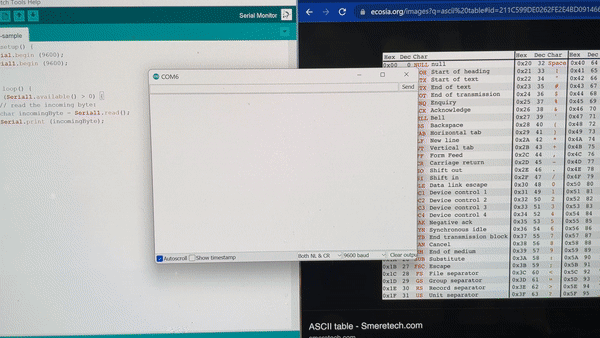fabacademy
week 13-18
week 13: input devices




learning outcome The first class after the easter holidays we continue electronics and after the the class outputs we learned things about different kind of inputs. For example there are different kind of sensors, like synthetic sensors, which are highly capable that can indirectly monitor a large context, without direct instrumentation of objects. Also there are other ones like static and moveable sensors, which can measure different things like : light, movement, touch (pressure) and so on. Sensors are often for capturing information and getting data. They are also different ways of working, some are “simple” they work with: yes or no / high or low / 1 or 0 / true or false, where you just have two situations.
reflection The next time I am focusing on electronics, I want to understand more and practise and experiment.
tasks After designing and milling the PCB design, I soldered the components to my pcb and tried it out. I have sensors for temperature and buttons. View code
week 14: networking & communications
learning outcome This week we went through the topic networking, which basically means copying information in two places. We use networks and communication protocols to distribute and connect systems due to: location (not everything is everywhere possible), parallelism (processes which work at the same time), modularity (how good it is scalable and exchangeable) and interference (which should not be there). The more information you send and the faster, the easier you get errors. But also there are different types: transmission media (cable, optic, radio frequency), topology and the range. Computerphile - videos

The networking could work wired or wireless. Wired you have different types as well. Serial and parallel. Parallel interfaces transfer multiple bits at the same time. They usually require buses of data - transmitting across eight, sixteen, or more wires. Can be with high speeds, but with a lot of wires. Serial interfaces stream their data with a reference signal, one single bit at a time These interfaces one wire, usually never more than four. Then you can make a difference in synchronous and asynchronous. Asynchronous works without an external clock, synchronous without. Asynchronous communication include: RX/TX and UART. Synchronous include I2C and SPI. The wireless version works with antennas like: monopole, dipole, helical, half Wave dipole or patch antenna´s. There is also a range-Power-Dbi Gain, where dB means decibels, we use this unit to measure the level of sound, but in radio we also use dB to measure signal strength.


reflection I just made a plan because i realised the master is almost over and also we need to finish all the deliveries.
tasks The task was to send a message between two microcontrollers (boards). First we set up the two microcontroller, with cables and bread board and connected them to the Arduino program. Also we followed the tutorial which included the “Writer” and “Reader” codes, where one microcontroller is the writer and the other one is the reader. We used the incoming byte 13 which refers to carriage return which will help us translate the numbers into letters. Also we added codes so we could see the name of the person sending the message. Then we connected both boards both ways so the communication would go forwards and backwards.
week 15: interface & application programming

learning outcome Interface & application programming are about designing, changing, applying different topics like: data interface, device interface, user interface, languages or graphics. Types for different interface & application programs are for example “Processing”, which is a Java graphical library. Also its built for the electronic arts, new media art, and visual design communities with the purpose of teaching non-programmers the fundamentals of computer programming in a visual context. It is similar to Arduino but coded in Java. Then we have “P5.js”, which is a JavaScript library and makes a web-based version of Processing. Also its ideal for web applications an implementations, which is keeping the same workflow as Processing. Then we have “Blender”, which can be used for 3D modelling, Video editing, producing CAM files and even interact with the real world, where the programming is working through Python. Then we have “MIT APP” to create software applications and open-source web application for Android. “A-frame” is for building virtual reality (VR) experiences. It’s a framework that provides a declarative, extensible, and composable structure to three.js, which is html based. And “Node red” is for visual programming developed originally by IBM for wiring together hardware devices, APIs and online services as part of the Internet of Things. Also it can create JavaScript functions. Blender examples P5.js examples
reflection I definitely want to try one of those programs. I think this will accompany us more and more in the future, both professionally and privately, and will be part of our lives. I want to be able to have a say and be somewhat familiar with the subject.
tasks I wanted o learn p5.js. So I started first with a tutorial, where I changed and tried out different things. Firt I changed the colors, which was not hard. Then I learned what different words mean, like “stroke” is frame and “strokeWeight” is the thickness of the frame. With “noCursor” and “noStroke” I could change the shape of the mouse, which color, shape etc. So in the third one I changed the mouse and edit the rotation of the “arc”. Also its nice to have “parameters” a the beginning to be able to change quickly all together. At last I added a title and subtitle with a chosen font, a frame and random points in the background.
week 16: wildcard week
learning outcome First we learned a lot about robotic arms, which could be used for laser cutting, 3d print or as a CNC mill. It could have up to 6 axes and if the external table is moveable it could get up to 9 axes. There are different steps to set the machine. First the rotation parts, where are forward and inverse kinematics and the most of the joints are limited in the rotation. Kinematics is a field of mechanics in which the motion of bodies is described purely geometrically with the quantities location, time, velocity and acceleration. Then you have movements in the cartesian coordinates: x,y,z, which is a orthogonal coordinate system. In the motion you can different types: linear (singularity) and joint (movement interpolations). Robotic machines work with planes and not with dots or lines.
To make a file first define your end effector (TCP, weight and geometry) using the “Create tool” component. Create a flat list of targets that define your tool path using the “Create target” component. Create a robot program connecting your list of targets and robot model to the “Create program” component. Preview the tool path using the “Simulation” component. Save the robot program to a file using the “Save program” component. If you’re using a UR robot, you can also use the “Remote UR” component to stream the program through a network. More information
reflection This week we had a wildcard week where we could decide on our own, what we want to do, which was nice, but during the class the teach us to use a robotic arm. It was very interesting and completely new for me. I would love to use it but I am also a bit critical about the usage, because I don’t really see how to apply it for normal people in daily life.
tasks For our next solar brunch we need to build another solar oven. Each time we are improving and changing things to make it more efficient. This time we wanted to use the glass of the fridge we found and have two boxes, so we can exchange the food seperatly while the other food is still cooking. After the 3D design with Fusion, Paula and me made a Rhino scetch and prepared everything with Rhino cam to have the G-code ready for the CNC-milling mashine.


week 17:application and implications
What will i do With my project I want to create first more awareness to our daily life while including different methods. With slow lab I want to bring people together and reconnect them with the nature. The slow lab comes from the slow movement, which means to slow things down instead of making everything fast, unconscious and without understanding and thinking about it. With slow lab I want to promote a resilient lifestyle. We are organising events, building several low tech products to generate energy and use the sunlight while combining old and new techniques and make tutorials and workshops to bring it to the people and make it accessible for everyone.
Who’s done what beforehand? There are some communities who have done that before but in Barcelona since Covid happened not so many are left. The “Low tech lab” in France is doing similar things, which are very inspiring. And in Barcelona we know the guy Kris from “Low tech magazine” who are we collaborating with for all our events and who we are working with when producing new low tech´s.
What will you design? I would like to design a complete low tech product line for your home which includes a fireless cooker (which is a cooker and seat in once), a evaporative cooler (which is cooling several drinks at the same time), a solar oven (which could be easily disassembled and cooks fast), fermentation accessories/kits, a dehydrator (which dries food just with the sun), a hydroponic system (which is low tech and saves water), a home bike generator (which generates electricity for your record player) and a dynamo bike generator (which generates electricity while traveling).
What materials and components will be used? Just materials which are accessible for everyone. The materials should not be hard to find and not be expensive. For slow lab its important that everyone can replicate it. That’s why we are using materials like wood and glass, which we found, to give them a second life and recycle. In total we are using: wood, glass, aluminium and fabric.
Where will it come from? With slow lab we want to reuse/ recycle materials as much as we can. Materials we have at home, products we could disassemble and reuse parts/ resources, from friends, neighbours or in vintage stores. Also we start to talk to local shops/companies/communities if its possible to exchange materials or get their “trash”, which could be for us very useful. For example the small solar oven is made out of an old wine box, so we thought about going to wine shops around Barcelona and ask if they are throwing them away.
How much will they cost? We thought about making different versions: one is more “do it yourself”, which is out of recycled materials to replicate and test it at home and the other ones we are going sell. We want to make a nice looking low tech product line, which fits good in modern apartment’s or houses and attracts more people than just the “hippies”. The diy ones we will sell too but for a lower price.
What processes will be used? While building the low tech´s fireless cooker, evaporative cooler, solar oven, fermentation accessories/kits, dehydrator, hydroponic system, home bike generator and a dynamo bike generator different fabrication processes should be done. For the dehydrator a cnc milling would be necessary to make it fast and precise. For the solar oven we could just use hand tools, in this case digital fabrication would be nice to make the boxes more accurate. The same for the hydroponic systems. Electronics will be only used in the two different bike generators, because we want to reduce it to the minimum.
How will it be evaluated? In the slow lab the low tech products (efficiency, accessibility, replicability,…), the events (Are they successful?, Are we earning money?, Are people coming back?), the community, the social media platform, the website including the tutorials, the communication and the impact could be evaluated. There are not only the physical goals, but also the one which are connected to the people. We want to involve people, get them out of their comfort zone and be part of the slow movement, where we are sharing different ways how to change their daily habits (slow cooking, slow traveling, slow living, slow farming, slow generating,…).
week 18:invention, intellectual property & income
This class we should create a business model about the Smart Cizien Kit. At the moment the collected data is assessable for everyone, the tool is opensource and easy to rebuilt and the price for one kit is 100€.
Every group should create a presentation and think about a possible marketing concept. My group include Adai, Audrey, Didac and me. We thought about a concept, where you can get a “Super Smart Citizen”. The data of the smart citizen kit is blocked unless you are owning a smart citizen kit, where you get the credentials. When owning the SCK you can use it for private use, but also its possible to apply for a program with the city hall to have a agreement about the data, where they get access from your collected data. The city hall offers places to exchange ideas and meet and have talks with all the other SCK-owners and offers city services as an exchange. Also you can join an open neighbourhood group to talk about your results and so on. To expand the SMK owner its possible to be part of the Spain/Europe program to talk about your results.
FABACADEMY